实验三 类和对象_基础编程2
实验任务 1
button.hpp

1 #pragma once 2 3 #include <iostream> 4 #include <string> 5 6 using std::string; 7 using std::cout; 8 9 // 按钮类 10 class Button { 11 public: 12 Button(const string &text); 13 string get_label() const; 14 void click(); 15 16 private: 17 string label; 18 }; 19 20 Button::Button(const string &text): label{text} { 21 } 22 23 inline string Button::get_label() const { 24 return label; 25 } 26 27 void Button::click() { 28 cout << "Button '" << label << "' clicked\n"; 29 }
window.hpp

1 #pragma once 2 #include "button.hpp" 3 #include <vector> 4 #include <iostream> 5 6 using std::vector; 7 using std::cout; 8 using std::endl; 9 10 // 窗口类 11 class Window{ 12 public: 13 Window(const string &win_title); 14 void display() const; 15 void close(); 16 void add_button(const string &label); 17 18 private: 19 string title; 20 vector<Button> buttons; 21 }; 22 23 Window::Window(const string &win_title): title{win_title} { 24 buttons.push_back(Button("close")); 25 } 26 27 inline void Window::display() const { 28 string s(40, '*'); 29 30 cout << s << endl; 31 cout << "window title: " << title << endl; 32 cout << "It has " << buttons.size() << " buttons: " << endl; 33 for(const auto &i: buttons) 34 cout << i.get_label() << " button" << endl; 35 cout << s << endl; 36 } 37 38 void Window::close() { 39 cout << "close window '" << title << "'" << endl; 40 buttons.at(0).click(); 41 } 42 43 void Window::add_button(const string &label) { 44 buttons.push_back(Button(label)); 45 }
task1.cpp

1 #include "window.hpp" 2 #include <iostream> 3 4 using std::cout; 5 using std::cin; 6 7 void test() { 8 Window w1("new window"); 9 w1.add_button("maximize"); 10 w1.display(); 11 w1.close(); 12 } 13 14 int main() { 15 cout << "用组合类模拟简单GUI:\n"; 16 test(); 17 }
运行结果截图:
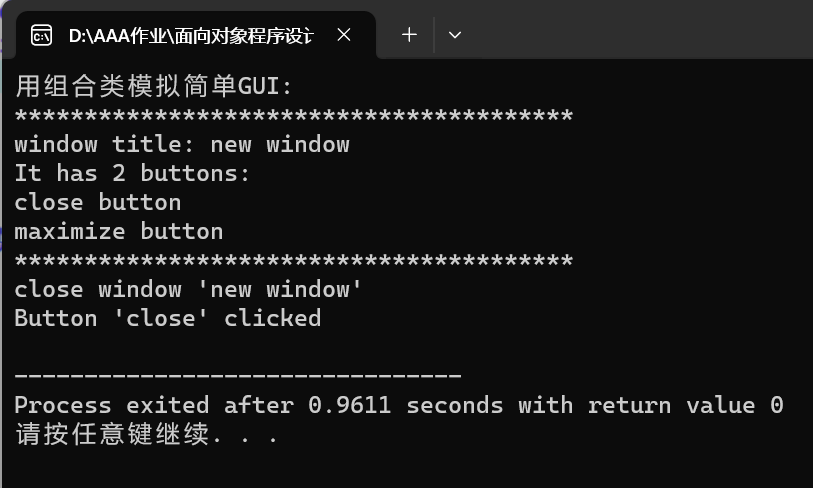
回答问题
问题1:这个模拟简单GUI的示例代码中,自定义了几个类?使用到了标准库的哪几个类?, 哪些类和类之间存在组合关系?
答: 自定义了两个类,分别为 button类 和 window类。
使用了标准库中 string类 和 vector容器类。
string和button string和window button和window button和vector
问题2:在自定义类Button和Window中,有些成员函数定义时加了const, 有些设置成了 inline。如果你是类的设计者,目前那些没有加const或没有设置成inline的,适合添加const, 适合设置成inline吗?你的思考依据是?
1、button类中的 string get_label() const;函数可以加 inline ,因为它的实现简单。
2、button类中的 viod click()函数可以改成 inline viod click()const;因为该函数内容只有一行,且可以防止该函数修改label的值。
3、window类中的 viod close()函数可以改成 inline viod close()const ;因为该函数实现简单,且可以防止其修改vector<button>中的值。
4、window类中的 viod add_button()函数适合加inline,但不适合加 const 因为需要这个函数修改vector 容器。
问题3:类Window的定义中,有这样一行代码,其功能是?

创建一个string类 s 并对 s 进行初始化 赋值给 s 40个‘ * ’。
实验任务 2
task2.cpp

1 #include <iostream> 2 #include <vector> 3 4 using namespace std; 5 6 void output1(const vector<int> &v) { 7 for(auto &i: v) 8 cout << i << ", "; 9 cout << "\b\b \n"; 10 } 11 12 void output2(const vector<vector<int>> v) { 13 for(auto &i: v) { 14 for(auto &j: i) 15 cout << j << ", "; 16 cout << "\b\b \n"; 17 } 18 } 19 20 void test1() { 21 vector<int> v1(5, 42); 22 const vector<int> v2(v1); 23 24 v1.at(0) = -999; 25 cout << "v1: "; output1(v1); 26 cout << "v2: "; output1(v2); 27 cout << "v1.at(0) = " << v1.at(0) << endl; 28 cout << "v2.at(0) = " << v2.at(0) << endl; 29 } 30 31 void test2() { 32 vector<vector<int>> v1{{1, 2, 3}, {4, 5, 6, 7}}; 33 const vector<vector<int>> v2(v1); 34 35 v1.at(0).push_back(-999); 36 cout << "v1: \n"; output2(v1); 37 cout << "v2: \n"; output2(v2); 38 39 vector<int> t1 = v1.at(0); 40 cout << t1.at(t1.size()-1) << endl; 41 42 const vector<int> t2 = v2.at(0); 43 cout << t2.at(t2.size()-1) << endl; 44 } 45 46 int main() { 47 cout << "测试1:\n"; 48 test1(); 49 50 cout << "\n测试2:\n"; 51 test2(); 52 }
运行结果截图:
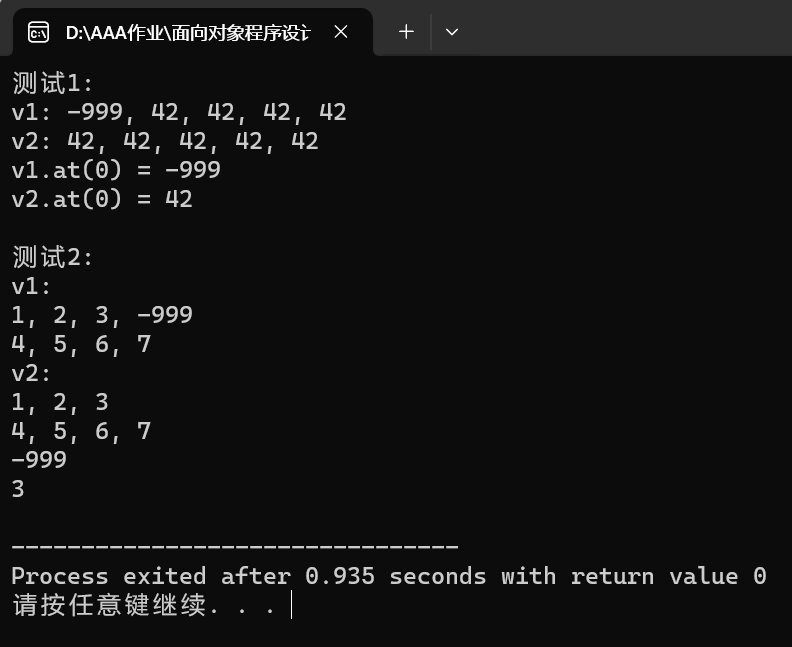
问题1:测试1模块中,这三行代码的功能分别是?

1、创建一个存放整型数据的vector容器 v1 并初始化为五个元素,每个元素的值为42.
2、创建一个存放整型数据的vector容器 v2 并通过深拷贝将 v1 的五个元素值赋值给 v2。
3、将 v1 的第一个元素值修改为 -999.
问题2:测试2模块中,这三行代码的功能分别是?

1、创建一个vector 容器 v1,该容器可以存放 可以存放整型数据的 vector 容器,并将 v1 初始化为{{1,2,3},{4,5,5}};
2、创建一 个不可修改的 vector 容器 v2,该容器可以存放 可以存放整型数据的 vector 容器,并通过深拷贝,用 v1 对 v2 进行初始化。
3、对 v1 的第一个 vector容器的最后添加元素 -999.
问题3:测试2模块中,这四行代码的功能分别是?

1、创建一个可以存放整型数据的 vector 容器 t1 ,并用 v1 中的第一个容器初始化 t1 。
2、输出 t1 中最后一个元素。
3、创建一 个不可修改的可以存放整型数据的 vector 容器 t2 ,并用 v2 中的第一个容器初始化 t2 。
4、输出 t2 中最后一个元素。
问题4:根据执行结果,反向分析、推断:
① 标准库模板类vector内部封装的复制构造函数,其实现机制是深复制还是浅复制?
深复制。
因为通过修改 v2 的元素值,但没有对 v1 造成影响。
② 模板类vector的接口at(), 是否至少需要提供一个const成员函数作为接口?
需要。
实验任务 3
vectorint.hpp

1 #pragma once 2 3 #include <iostream> 4 #include <cassert> 5 6 using std::cout; 7 using std::endl; 8 9 // 动态int数组对象类 10 class vectorInt{ 11 public: 12 vectorInt(int n); 13 vectorInt(int n, int value); 14 vectorInt(const vectorInt &vi); 15 ~vectorInt(); 16 17 int& at(int index); 18 const int& at(int index) const; 19 20 vectorInt& assign(const vectorInt &v); 21 int get_size() const; 22 23 private: 24 int size; 25 int *ptr; // ptr指向包含size个int的数组 26 }; 27 28 vectorInt::vectorInt(int n): size{n}, ptr{new int[size]} { 29 } 30 31 vectorInt::vectorInt(int n, int value): size{n}, ptr{new int[size]} { 32 for(auto i = 0; i < size; ++i) 33 ptr[i] = value; 34 } 35 36 vectorInt::vectorInt(const vectorInt &vi): size{vi.size}, ptr{new int[size]} { 37 for(auto i = 0; i < size; ++i) 38 ptr[i] = vi.ptr[i]; 39 } 40 41 vectorInt::~vectorInt() { 42 delete [] ptr; 43 } 44 45 const int& vectorInt::at(int index) const { 46 assert(index >= 0 && index < size); 47 48 return ptr[index]; 49 } 50 51 int& vectorInt::at(int index) { 52 assert(index >= 0 && index < size); 53 54 return ptr[index]; 55 } 56 57 vectorInt& vectorInt::assign(const vectorInt &v) { 58 delete[] ptr; // 释放对象中ptr原来指向的资源 59 60 size = v.size; 61 ptr = new int[size]; 62 63 for(int i = 0; i < size; ++i) 64 ptr[i] = v.ptr[i]; 65 66 return *this; 67 } 68 69 int vectorInt::get_size() const { 70 return size; 71 }
task3.cpp

1 #include "vectorInt.hpp" 2 #include <iostream> 3 4 using std::cin; 5 using std::cout; 6 7 void output(const vectorInt &vi) { 8 for(auto i = 0; i < vi.get_size(); ++i) 9 cout << vi.at(i) << ", "; 10 cout << "\b\b \n"; 11 } 12 13 14 void test1() { 15 int n; 16 cout << "Enter n: "; 17 cin >> n; 18 19 vectorInt x1(n); 20 for(auto i = 0; i < n; ++i) 21 x1.at(i) = i*i; 22 cout << "x1: "; output(x1); 23 24 vectorInt x2(n, 42); 25 vectorInt x3(x2); 26 x2.at(0) = -999; 27 cout << "x2: "; output(x2); 28 cout << "x3: "; output(x3); 29 } 30 31 void test2() { 32 const vectorInt x(5, 42); 33 vectorInt y(10, 0); 34 35 cout << "y: "; output(y); 36 y.assign(x); 37 cout << "y: "; output(y); 38 39 cout << "x.at(0) = " << x.at(0) << endl; 40 cout << "y.at(0) = " << y.at(0) << endl; 41 } 42 43 int main() { 44 cout << "测试1: \n"; 45 test1(); 46 47 cout << "\n测试2: \n"; 48 test2(); 49 }
运行结果截图:
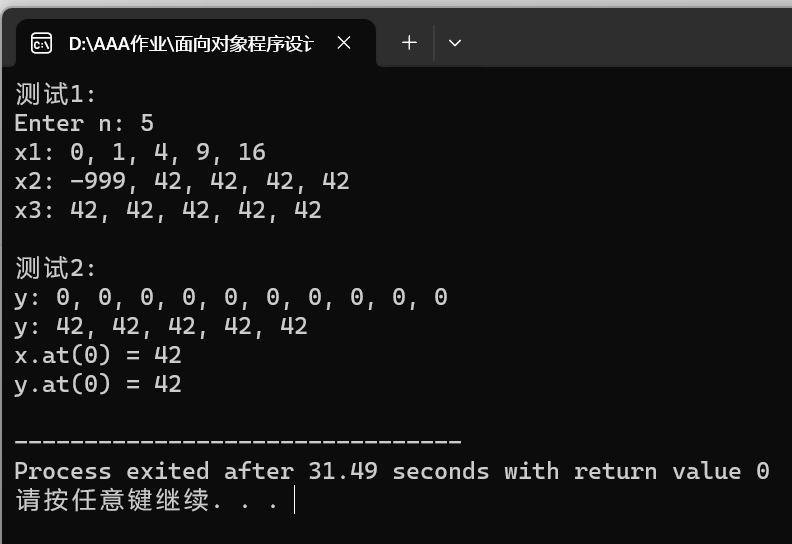
阅读、理解代码,与标准库模板类vector对比,分析、观察自定义类vectorInt的设计、实现,回答 问题:
问题1:vectorInt类中,复制构造函数(line14)的实现,是深复制还是浅复制?
深拷贝。
line14 的实现是通过 new 再次在堆区上开辟新的空间,然后通过值的赋值对新开辟的空间进行初始化。
问题2:vectorInt类中,这两个at()接口,如果返回值类型改成int而非int&(相应地,实现部分也 同步修改),测试代码还能正确运行吗?如果把line18返回值类型前面的const掉,针对这个测试 代码,是否有潜在安全隐患?尝试分析说明。
不能正常运行,使用int& 可以直接对索引的位置进行值的修改。
存在安全隐患。可能会导致通过引用传递的参数可能会在函数内部被意外修改。
问题3:vectorInt类中,assign()接口,返回值类型可以改成vectorInt吗?你的结论及原因分析。
不可以。在函数调用后函数内的类会被析构,使得返回的值不可预料。
实验任务 4
Matrix.cpp

1 #pragma once 2 3 #include <iostream> 4 #include <cassert> 5 6 using std::cout; 7 using std::endl; 8 9 // 类Matrix的声明 10 class Matrix { 11 public: 12 Matrix(int n, int m); // 构造函数,构造一个n*m的矩阵, 初始值为value 13 Matrix(int n); // 构造函数,构造一个n*n的矩阵, 初始值为value 14 Matrix(const Matrix &x); // 复制构造函数, 使用已有的矩阵X构造 15 ~Matrix(); 16 17 void set(const double *pvalue); // 用pvalue指向的连续内存块数据按行为矩阵赋值 18 void clear(); // 把矩阵对象的值置0 19 20 const double& at(int i, int j) const; // 返回矩阵对象索引(i,j)的元素const引用 21 double& at(int i, int j); // 返回矩阵对象索引(i,j)的元素引用 22 23 int get_lines() const; // 返回矩阵对象行数 24 int get_cols() const; // 返回矩阵对象列数 25 26 void display() const; // 按行显示矩阵对象元素值 27 28 private: 29 int lines; // 矩阵对象内元素行数 30 int cols; // 矩阵对象内元素列数 31 double *ptr; 32 }; 33 34 // 类Matrix的实现:待补足 35 // xxx 36 37 Matrix::Matrix(int n, int m):lines(n),cols(m),ptr(new double[n*m]) 38 { 39 for (int i = 0; i < lines * cols; i++) 40 ptr[i] = 0; 41 } 42 43 Matrix::Matrix(int n) :lines(n), cols(n), ptr(new double[n * n]) 44 { 45 for (int i = 0; i < lines * cols; i++) 46 ptr[i] = 0; 47 } 48 49 Matrix::Matrix(const Matrix& x):lines(x.lines),cols(x.cols),ptr(new double[lines*cols]) 50 { 51 for (int i = 0; i < lines * cols; i++) 52 ptr[i] = x.ptr[i]; 53 } 54 55 Matrix::~Matrix() { delete[] ptr; } 56 57 void Matrix::set(const double* pvalue) 58 { 59 assert(pvalue != nullptr); 60 for (int i = 0; i < lines * cols; i++) 61 ptr[i] = *(pvalue + i); 62 //这里无法判断pvalue指针是否非法越界 63 } 64 65 void Matrix::clear() 66 { 67 for (int i = 0; i < lines * cols; i++) 68 ptr[i] = 0; 69 } 70 71 const double& Matrix::at(int i, int j)const 72 { 73 assert(i >= 0 && i < lines && j >= 0 && j < cols); 74 return ptr[i * cols + j]; 75 } 76 77 double& Matrix::at(int i, int j) 78 { 79 assert(i >= 0 && i < lines && j >= 0 && j < cols); 80 return ptr[i * cols + j]; 81 } 82 83 int Matrix::get_lines()const { return lines; } 84 85 int Matrix::get_cols()const { return cols; } 86 87 void Matrix::display()const 88 { 89 for (int i = 0; i < lines; i++) 90 { 91 for (int j = 0; j < cols; j++) 92 { 93 cout << ptr[i * cols + j] << " "; 94 } 95 cout << endl; 96 } 97 cout << endl; 98 }
task4.cpp

1 #include "matrix.hpp" 2 #include <iostream> 3 #include <cassert> 4 5 using std::cin; 6 using std::cout; 7 using std::endl; 8 9 10 const int N = 1000; 11 12 // 输出矩阵对象索引为index所在行的所有元素 13 void output(const Matrix &m, int index) { 14 assert(index >= 0 && index < m.get_lines()); 15 16 for(auto j = 0; j < m.get_cols(); ++j) 17 cout << m.at(index, j) << ", "; 18 cout << "\b\b \n"; 19 } 20 21 22 void test1() { 23 double x[1000] = {1, 2, 3, 4, 5, 6, 7, 8, 9}; 24 25 int n, m; 26 cout << "Enter n and m: "; 27 cin >> n >> m; 28 29 Matrix m1(n, m); // 创建矩阵对象m1, 大小n×m 30 m1.set(x); // 用一维数组x的值按行为矩阵m1赋值 31 32 Matrix m2(m, n); // 创建矩阵对象m1, 大小m×n 33 m2.set(x); // 用一维数组x的值按行为矩阵m1赋值 34 35 Matrix m3(2); // 创建一个2×2矩阵对象 36 m3.set(x); // 用一维数组x的值按行为矩阵m4赋值 37 38 cout << "矩阵对象m1: \n"; m1.display(); cout << endl; 39 cout << "矩阵对象m2: \n"; m2.display(); cout << endl; 40 cout << "矩阵对象m3: \n"; m3.display(); cout << endl; 41 } 42 43 void test2() { 44 Matrix m1(2, 3); 45 m1.clear(); 46 47 const Matrix m2(m1); 48 m1.at(0, 0) = -999; 49 50 cout << "m1.at(0, 0) = " << m1.at(0, 0) << endl; 51 cout << "m2.at(0, 0) = " << m2.at(0, 0) << endl; 52 cout << "矩阵对象m1第0行: "; output(m1, 0); 53 cout << "矩阵对象m2第0行: "; output(m2, 0); 54 } 55 56 int main() { 57 cout << "测试1: \n"; 58 test1(); 59 60 cout << "测试2: \n"; 61 test2(); 62 }
运行结果截图:
double x[1000] = { 2,4,6,8,10,12,14,16,18,20 };
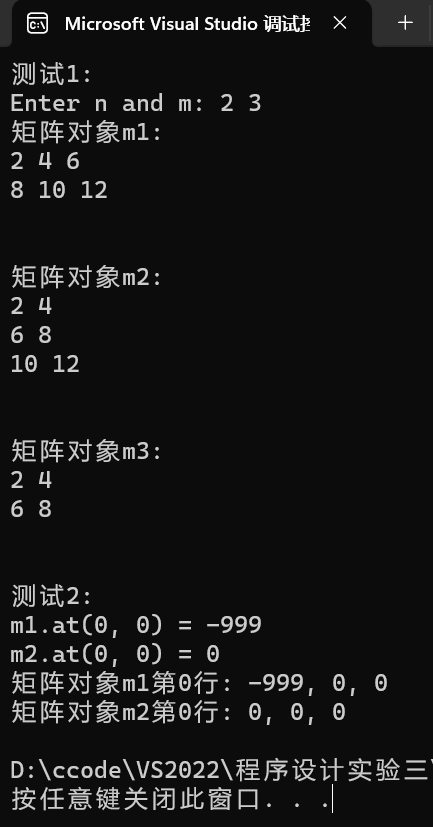
实验任务 5
user.cpp

1 #pragma once 2 #include<iostream> 3 #include<string> 4 #include<iomanip> 5 using namespace std; 6 7 class User 8 { 9 public: 10 User(string Name, string Password = "112233", string Email = "xyz@gmail.com"); 11 12 13 void set_email(); 14 15 void change_password(); 16 17 void display()const; 18 19 20 private: 21 string name; 22 string password; 23 string email; 24 25 26 }; 27 28 29 30 User::User(string Name,string Password,string Email):name(Name),password(Password),email(Email){} 31 32 void User::set_email() 33 { 34 cout << "Enter email address: "; 35 string Email; 36 label: 37 cin >> Email; 38 if (Email.find('@') != string::npos) 39 { 40 email = Email; 41 cout << "email is set successfully..." << endl; 42 } 43 else 44 { 45 cout << "illegal email. Please re-enter email: "; 46 goto label; 47 } 48 } 49 50 void User::change_password() 51 { 52 cout << "Enter old password: "; 53 int count = 0; 54 string Password; 55 label: 56 cin >> Password; 57 count++; 58 if (password == Password) 59 { 60 cout << "Enter new password: "; 61 cin >> Password; 62 password = Password; 63 cout << "new password is set successfully..." << endl; 64 } 65 else 66 { 67 cout << "password input error. "; 68 if (count >= 3) { cout << "Please try after a while." << endl; count = 0; } 69 else { cout << "Please re-enter angain: "; goto label; } 70 } 71 } 72 73 void User::display()const 74 { 75 cout << left << setw(10) << "name:" << name << endl; 76 string p(password.length(), '*'); 77 cout << left << setw(10) << "pass:" << p << endl; 78 cout << left << setw(10) << "email:" << email << endl; 79 }
task5.cpp

1 #include"User.hpp" 2 #include <iostream> 3 #include <vector> 4 #include <string> 5 6 using std::cin; 7 using std::cout; 8 using std::endl; 9 using std::vector; 10 using std::string; 11 12 void test() { 13 vector<User> user_lst; 14 15 User u1("Alice", "2024113", "Alice@hotmail.com"); 16 user_lst.push_back(u1); 17 cout << endl; 18 19 User u2("Bob"); 20 u2.set_email(); 21 u2.change_password(); 22 user_lst.push_back(u2); 23 cout << endl; 24 25 User u3("Hellen"); 26 u3.set_email(); 27 u3.change_password(); 28 user_lst.push_back(u3); 29 cout << endl; 30 31 cout << "There are " << user_lst.size() << " users. they are: " << endl; 32 for(auto &i: user_lst) { 33 i.display(); 34 cout << endl; 35 } 36 } 37 38 int main() { 39 test(); 40 }
运行结果截图:

实验任务 6
date.h

1 //date.h 2 #ifndef __DATE_H__ 3 #define __DATE_H__ 4 class Date { 5 //日期类 6 private: 7 int year; 8 //年 9 int month; 10 //月 11 int day; 12 //日 13 int totalDays; 14 //该日期是从公元元年1月1日开始的第几天 15 public: 16 Date(int year, int month, int day); 17 //用年、月、日构造日期 18 int getYear() const { return year; } 19 int getMonth() const { return month; } 20 int getDay() const { return day; } 21 int getMaxDay() const; 22 //获得当月有多少天 23 bool isLeapYear() const { 24 //判断当年是否为闰年 25 return year % 4 == 0 && year % 100!= 0 || year % 400 == 0; 26 } 27 void show() const; 28 //输出当前日期 29 int distance(const Date& date) const { 30 return totalDays - date.totalDays; 31 } 32 }; 33 #endif //__DATE_H__
date.cpp

1 //date.cpp 2 #include "date.h" 3 #include <iostream> 4 #include <cstdlib> 5 using namespace std; 6 namespace { 7 //namespace使下面的定义只在当前文件中有效 8 const int DAYS_BEFORE_MONTH[] = {0, 31, 59, 90, 120, 151, 181, 212, 243, 273, 304, 334, 356}; 9 } 10 Date::Date(int year, int month, int day) :year(year),month(month),day(day){ 11 if (day <= 0 || day > getMaxDay()) { 12 cout << "Invalid date: "; 13 show(); 14 cout << endl; 15 exit(1); 16 } 17 int years = year - 1; 18 totalDays = years * 365 + years / 4 - years / 100 + years / 400 + DAYS_BEFORE_MONTH[month - 1] + day; 19 if (isLeapYear() && month > 2) totalDays++; 20 } 21 int Date::getMaxDay() const { 22 if (isLeapYear() && month == 2) return 29; 23 else return DAYS_BEFORE_MONTH[month] - DAYS_BEFORE_MONTH[month - 1]; 24 } 25 void Date::show() const { 26 cout << getYear() << "-" << getMonth() << "-" << getDay(); 27 }
account.h

1 //account.h 2 #ifndef __ACCOUNT_H__ 3 #define __ACCOUNT_H__ 4 #include "date.h" 5 #include <string> 6 class SavingsAccount { 7 //储蓄账户类 8 private: 9 std::string id; 10 //账号 11 double balance; 12 //余额 13 double rate; 14 //存款的年利率 15 Date lastDate; 16 //上次变更余额的时期 17 double accumulation; 18 //按日累加以和 19 static double total; 20 //所有账户的总金额 21 //记录一笔账,date为日期,amount为金额,desc为说明 22 void record(const Date &date, double amount, const std::string &desc); 23 //报告错误信息 24 void error(const std::string &msg) const; 25 //获得指定日期为止的存款金额按日累增值 26 double accumulate(const Date &date) const { 27 return accumulation + balance * date.distance(lastDate); 28 } 29 public: 30 //构造函数 31 SavingsAccount(const Date &date, const std::string &id, double rate); 32 //获得账号 33 const std::string &getId() const { return id; } 34 //获得余额 35 double getBalance() const { return balance; } 36 //获得年利率 37 double getRate() const { return rate; } 38 static double getTotal() { return total; } 39 //存入现金 40 void deposit(const Date &date, double amount, const std::string &desc); 41 //取出现金 42 void withdraw(const Date &date, double amount, const std::string &desc); 43 //结算利息,每年1月1日调用一次该函数 44 void settle(const Date &date); 45 //显示账户信息 46 void show() const; 47 }; 48 #endif //__ACCOUNT_H__
account.cpp

1 //account.cpp 2 #include "account.h" 3 #include <cmath> 4 #include <iostream> 5 using namespace std; 6 double SavingsAccount::total = 0; 7 //SavingsAccount类相关成员函数的实现 8 SavingsAccount::SavingsAccount(const Date &date, string id, double rate) : id(id), balance(0), rate(rate), lastDate(date), accumulation(0) { 9 date.show(); 10 cout << "\t#" << id << " created" << endl; 11 } 12 void SavingsAccount::record(const Date &date, double amount, const string &desc) { 13 accumulation = accumulate(date); 14 lastDate = date; 15 amount = floor(amount * 100 + 0.5) / 100; 16 //保留小数点后两位 17 balance += amount; 18 total += amount; 19 date.show(); 20 cout << "\t#" << id << "\t" << amount << "\t" << balance << "\t" << desc << endl; 21 } 22 void SavingsAccount::error(const string &msg) const { 23 cout << "Error(#" << id << "): " << msg << endl; 24 } 25 void SavingsAccount::deposit(const Date &date, double amount, const string &desc) { 26 record(date, amount, desc); 27 } 28 void SavingsAccount::withdraw(const Date &date, double amount, const string &desc) { 29 if (amount > getBalance()) 30 error("not enough money"); 31 else 32 record(date, -amount, desc); 33 } 34 void SavingsAccount::settle(const Date &date) { 35 double interest = accumulate(date) * rate / date.distance(Date(date.getYear() - 1, 1, 1)); 36 if (interest!= 0) 37 record(date, interest, "interest"); 38 accumulation = 0; 39 } 40 void SavingsAccount::show() const { 41 cout << "ID: " << id << "\tBalance: " << balance; 42 }
task6.cpp

1 //6.25.cpp 2 #include "account.h" 3 #include <iostream> 4 using namespace std; 5 int main() { 6 Date date(2008, 11, 1); 7 //起始日期 8 //建立几个账户 9 SavingsAccount accounts[] = { 10 SavingsAccount(date, "03755217", 0.015), 11 SavingsAccount(date, "02342342", 0.015) 12 }; 13 //几笔账目 14 accounts[0].deposit(Date(2008, 11, 5), 5000, "salary"); 15 accounts[1].deposit(Date(2008, 11, 25), 10000, "sell stock 0323"); 16 accounts[0].deposit(Date(2008, 12, 5), 5500, "salary"); 17 accounts[1].withdraw(Date(2008, 12, 20), 4000, "buy a laptop"); 18 //结算所有账户并输出各个账户信息 19 cout << endl; 20 for (int i = 0; i < sizeof(accounts) / sizeof(SavingsAccount); i++) { 21 accounts[i].settle(Date(2009, 1, 1)); 22 accounts[i].show(); 23 cout << endl; 24 } 25 cout << "Total: " << SavingsAccount::getTotal() << endl; 26 return 0; 27 }
运行结果截图:
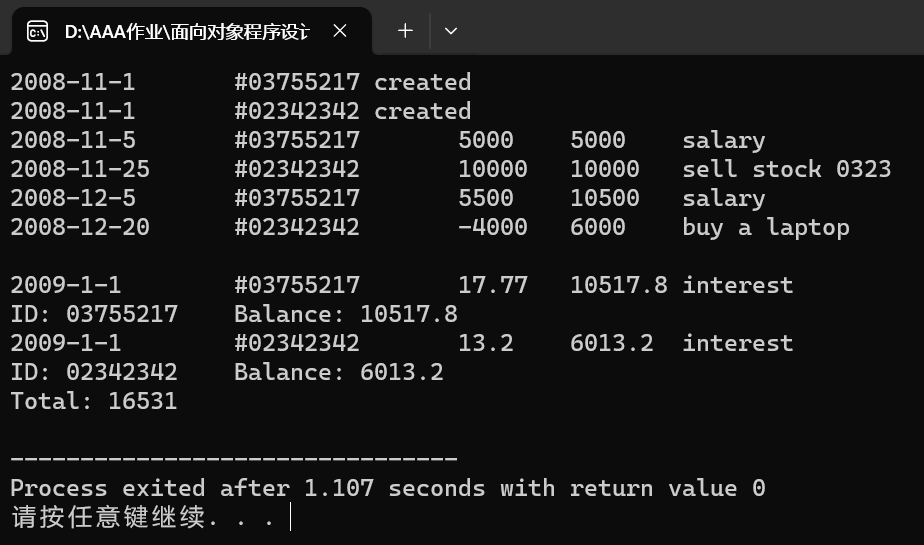
阅读、理解代码,分析这一版在类的抽象设计和实现上做了哪些改进。
1、将数据成员设为私有类,并通过公有函数接口进行获取和修改,确保了数据的安全性和一致性。
2、功能的完整性,Date类中为日期的计算提供了便利,提供了判断闰年、获取当月最大天数的函数,增强了类的实用性。
关注教材代码在实现细节上,是否有可以优化的部分?基于你的发现,改进、优化一些代码细节。
1、应尽量避免使用 using namespace std 这种全局的命名空间引用方式。
2、Date类中当日期无效时直接调用 exit(0) 退出程序过于粗暴,可以抛出异常,让用户自行决定是否修改日期。
3、在日期计算和利息计算时可以进行优化修改。






【推荐】国内首个AI IDE,深度理解中文开发场景,立即下载体验Trae
【推荐】编程新体验,更懂你的AI,立即体验豆包MarsCode编程助手
【推荐】抖音旗下AI助手豆包,你的智能百科全书,全免费不限次数
【推荐】轻量又高性能的 SSH 工具 IShell:AI 加持,快人一步
· 震惊!C++程序真的从main开始吗?99%的程序员都答错了
· winform 绘制太阳,地球,月球 运作规律
· 【硬核科普】Trae如何「偷看」你的代码?零基础破解AI编程运行原理
· 上周热点回顾(3.3-3.9)
· 超详细:普通电脑也行Windows部署deepseek R1训练数据并当服务器共享给他人